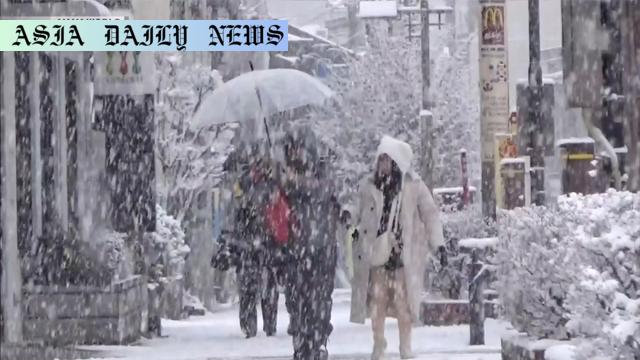Heavy Snow causes significant accumulation, with up to 80 cm expected in Tohoku. Authorities urge caution for traffic and avalanches.
Key Point 1: Heavy snow forecast in regions along Japan’s Sea of Japan coast due to winter pressure patterns and cold air masses.
Key Point 2: Accumulation of up to 80 cm in Tohoku, 70 cm in Niigata, and 60 cm in Hokuriku regions expected during the peak snowfall.
Key Point 3: Authorities warn of traffic disruptions, avalanches, reduced visibility from blizzards, and additional risks.
Key Point 4: Residents urged to prepare for hazards like snow accumulation on rooftops or electric wires.

Heavy Snowfall Predicted Across Northern and Eastern Japan
Japan is bracing for a severe winter weather phenomenon, with heavy snowfall expected to impact regions along the Sea of Japan coastline. The Japan Meteorological Agency (JMA) has issued warnings as a winter pressure pattern and cold air masses bring intense snow to the Tohoku, Hokuriku, Niigata, Gifu, and northern Kanto regions. Specific areas are bracing for rapid snow accumulation due to the inflow of dense snow clouds.
Projected Snow Accumulation and Affected Areas
According to JMA forecasts, Tohoku could see up to 80 centimeters of snowfall within the 24-hour period leading up to Thursday evening. Niigata and Gifu prefectures may experience up to 70 centimeters, while Hokuriku is likely to receive 60 centimeters. Hokkaido can expect 50 centimeters of snow accumulation, and northern Kanto and Nagano prefectures may see up to 40 centimeters.
Extended Forecast into Friday
The snowfall is set to continue through Friday evening, with northern Kanto forecasted to receive an additional 50 centimeters. Tohoku, Hokuriku, Niigata, and Nagano regions are also anticipated to experience 40 centimeters more, while Hokkaido and Gifu should expect snow piles of up to 30 centimeters. The persistent snowfall may exacerbate hazardous conditions in the affected areas.
Key Concerns Highlighted by Authorities
The heavy snow has raised significant concerns among weather officials regarding potential traffic disruptions, avalanches, and severe visibility reduction caused by blizzards. Snow could accumulate on rooftops or infrastructure, posing risks to residents and infrastructure alike. Individuals commuting or traveling through these regions are advised to exercise extreme caution and stay updated on weather reports and advisories.
Preparedness and Safety Measures
Residents and authorities are encouraged to prepare for the severe snowstorm by securing homes, clearing accumulated snow, and ensuring adequate supplies for potential emergencies. Commuters are also urged to check road conditions and avoid non-essential travel. Additional warnings have been issued to ensure safety against falling snow from rooftops and branches, and the possibility of snow sticking to electrical wires, potentially causing power outages.
Impact on Transport and Regional Infrastructure
The heavy snow is likely to disrupt transportation networks across railways, expressways, and local roads. Airports in affected regions might also face delays or cancellations due to the adverse weather conditions. Local governments have deployed snowplows and are advising people to minimize travel to prevent accidents or incidents.
Ongoing Monitoring and Updates
The Meteorological Agency continues to monitor the situation and will provide timely updates to the public. It remains critical for residents and travelers in the affected regions to stay informed and heed emergency directives issued by local authorities. Preparedness is key to mitigating risks associated with this severe weather pattern.
Commentary
A Resilient Response to Nature’s Wrath
The recent forecast of heavy snow across Japan’s Sea of Japan coast showcases the unpredictability and intensity of winter weather patterns. Living in an era where weather forecasting can save lives and prevent significant disruptions, one cannot underestimate the importance of the Japan Meteorological Agency’s communications. Their proactive approach in warning residents and issuing detailed forecasts reflects the importance of preparedness in mitigating natural disasters.
Impact on Daily Life and Infrastructure
Heavy snowfall impacts not only an individual’s daily commute but also the broader economic and infrastructure framework of a region. From disrupted transport systems to power outages caused by snow-laden wires, the cascading effects are a reminder of our vulnerability to nature’s forces. Authorities and local governments have done well in preparing snow-clearing equipment, advisories, and emergency response measures. Their efforts ensure that lives are protected, a significant consideration during harsh weather conditions.
The Need for Community Resilience
As Japan braces itself for this snowstorm, it is heartening to see how community resilience often emerges in times of crises. From helping neighbors shovel driveways to providing supplies, the human spirit of collaboration shines brightly during such challenges. Japan, known for its preparation and response to natural phenomena, demonstrates the importance of preparedness, education, and a collective approach to tackling climate-related adversities.


